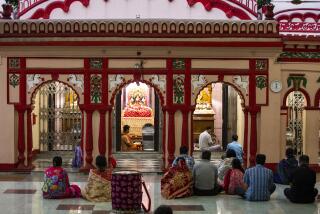India’s Agony
- Share via
The Arthur M. Sackler Gallery in Washington, D.C., has a current show that should be instructive to the know-nothings of India who are contending that advocates of religions other than Hinduism should be expelled.
It features paintings that Jesuits in the 16th and 17th centuries transported from their encampment in Goa, then ruled by the Portuguese, to the grand mogul’s court in Lahore. The Catholics’ illustrated Bibles were a hit with the Muslim rulers; court artists copied pictures of angels and Christian symbols for inclusion in their Islamic art. The ruler Akbar in turn used the paintings to re-inforce the concept of the divine approval of his reign.
India prides itself on its mixture of Hindus, Muslims, Sikhs, Buddhists, Jains, Christians and Jews. Over the years severe religious violence has occurred, but, still, India’s rulers always have stressed tolerance. However, earlier this month Christians across the country staged protests against increased incidents of anti-Christian violence, some of which they charged occurred with the complicity of government officials. A Christian group said there had been 90 cases of rape, Bible-burning and church desecration this year, more than twice the number reported in the previous 30 years.
Although Home Affairs Minister Lal K. Advani has issued a ringing call for the execution of the men who raped four nuns, many practitioners of India’s minority religions do not trust him. Advani is under investigation for a possible connection to anti-Muslim riots six years ago when Hindus demolished a Muslim mosque in Ayodhya.
Christians say it is no coincidence that the attacks rose in the year that Advani and his Bharatiya Janata Party took power. Some party members are virulently pro-Hindu, demanding that the government deport all missionaries, who they contend force people to convert. But the Indian government expelled most foreign missionaries decades ago, and Roman Catholic and Methodist church leaders say their ranks have almost no foreigners.
It is also not enough to argue that with so many people and so many religions, quarrels are bound to occur. Nor is it enough to say, as the government has, that some of the violence appeared to be religious but was really economic. The BJP government needs to follow the example of the Congress Party, which ruled India for most of the half-century of independence and repeatedly proclaimed the nation a secular democracy. A country that is a home to all of the world’s major religions has to provide freedom for adherents of all faiths.
As the Sackler exhibit notes, the Jesuits debated adherents of other religions at Akbar’s court and hoped to convert the ruler to Christianity. They failed. He was secure enough in his religion that he welcomed all points of view. India’s current government should reemphasize that tradition.
More to Read
Sign up for Essential California
The most important California stories and recommendations in your inbox every morning.
You may occasionally receive promotional content from the Los Angeles Times.













